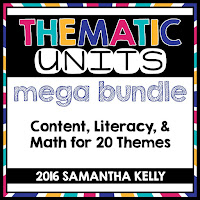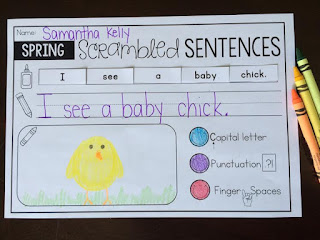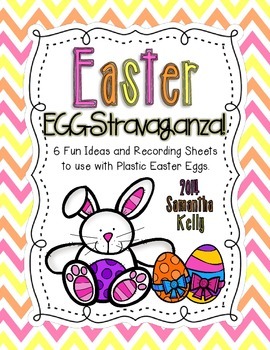Writing at the beginning of the year in kindergarten is all about building confidence. The kids have to see themselves as writers - even when that just means drawing pictures or writing squiggles. It can feel like a slow start, but it's so important that as we develop these tiny writers, we take our time to build them up step by step.

I start early in the year by introducing the structure and purpose of our writer's workshop. Kids learn what and why writers write with an emphasis on the fact that THEY ARE WRITERS! They learn the structure of our writer's workshop. Each day, writer's workshop consists of a minilesson, writing time, and sharing time. During the minilesson, we look closely at a mentor text or writing example to learn a particular strategy. The teacher models and guides students through practice, then releases them for writing time. The number one rule of writing time is that students are working the entire time. The teacher can take this time to do individual or small group writing conferences. Finally, comes share time, where students share their work with one another and the teacher can highlight some things that went well.

My writers use writing binders to store their work and to hold reference materials. They can decorate their own cover, then slip it inside the front of the binder. Inside the binder, we have charts, posters, and checklists that students can use to aid their writing. They are placed in plastic sheet protectors to keep them in good shape for the whole year. In the left pocket of the binder, students will keep works in progress. When they have finished a piece, it moves over to the right pocket of their binder. Students can always access these "finished" pieces and add more to them!
To kick off our writer's workshop, the kids learn the process they will follow for writing in Kindergarten. I emphasize four steps - think, draw, label, and write. I leave this anchor chart or a smaller poster up in the room all year long. Also, toward the end of the year, we start working on revising by adding detail to their pictures and words.

We start the writing process with thinking. Students brainstorm a list of topics that are of interest to them - things they love and things they know a lot about. These will serve as inspiration for their stories! Students learn that before they can write, they have to think of a story. We practice this with oral storytelling. Students practice sharing opinions, facts, and narratives out loud to their peers. They learn the importance of including details in their stories AND learn some crucial speaking and listening skills which are so important to emphasize at the beginning of the year. The motto we take on for oral storytelling is LOUD AND PROUD! This teaches students that their stories matter!

After learning to think of and tell a story, students get their first practice of putting their story down on paper - through pictures! Before I ever ask students to write a story, I teach them to tell their story through drawings. They learn to draw the who, what, when, and where of their stories. They learn to convey emotion through faces and colors in their drawings. They learn that their drawings represent their thoughts and are just as important as words.
Here's a chart we make to teach students to put their best effort forward in their drawings. They learn to color using appropriate colors, in the lines, and to fill up all the white space. We leave the poster up all year long and remind students often to make three star pictures.

After students have practiced thinking, telling, and drawing their stories, we start to dabble in writing. A good place to start is with one word labels. Students learn that labels help tell their story by telling what something is. It's a great way to ease into inventive spelling and letter-sound correspondence without overwhelming. We learn how to stretch out words by saying them slow like a turtle, listening for the sounds, then writing the letters that represent those sounds. We practice labeling many ways before asking students to label their own drawings. Remember, students will be at a different place in their writing journey! Many of your students will be able to point and tell you what their label says, despite it being a squiggle or a random string of letters. Other students will produce the letter that represents the beginning sound of their word, some will get the beginning and ending sounds. What's important is that their writing is validated and that you are CONSTANTLY modeling phonemic spelling and asking for students to engage in phonemic spelling with you! We do a LOT of shared writing outside of workshop time, too.

Finally, it's time for students to practice crafting sentences. It is still very early in the year and these beginning writing experiences are introductory - allowing students to view themselves as writers and get their toes wet. All of these strategies and rules they have learned in these five weeks will be elaborated on throughout the year in their genre writing and reinforced through shared writing experiences and independent practice. As students are learning about writing sentences in writing, they are also learning to read sentences in reading! They are learning the difference between letters, words, and sentences among other important concepts of print. ALWAYS do your best to connect across the curriculum. When my students are learning to write a sentence, they learn that if they can think it, they can say it, and if they can say it, they can write it. Writing is NOT a silent time in my classroom. Students are whispering words, stretching sounds, repeating, and rereading! This is what writing in action looks and sounds like! We go through introductory lessons on using the word wall, spacing words with finger spaces, starting with capital letters, ending with punctuation, and there is SO SO SO much modeling. In the end, students are crafting simple sentences which THEY can read and that match their labeled pictures!

I cannot emphasize this enough... the most important thing for students to learn at the beginning of the year is that they ARE writers and they have stories worth sharing. Ignite that fire and you will see tremendous growth throughout the year. And there is absolutely nothing better, nothing that makes this kindergarten heart smile bigger, than the pride on my little writers' faces when they are sharing their work!
Everything I talked about in this post is available in my Beginning Writing unit. It can all be adapted for first grade just by digging a little deeper and stretching a little further. It's also available in my Writers' Workshop Bundle (which also includes units on opinion, informational, personal narrative, and how-to writing!) Click the images below to check them out!
Grab the alphabet chart from this set for FREE! Color or b/w! Print it as is and put in kids' writing binders. And you can even blow it up using print settings and create a large anchor chart to hang in the room. Just click the image below to download!




































































